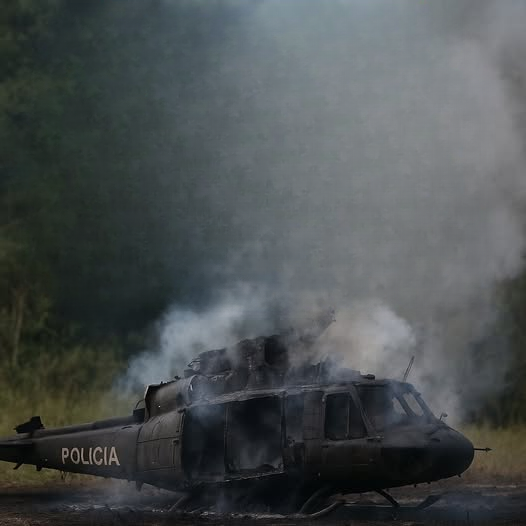In a tragic event that has once again highlighted the risks of Colombia’s decades-long battle against organized crime, at least ten police officers lost their lives when a helicopter was brought down during an anti-narcotics operation in a remote jungle region. Several others sustained serious injuries. Authorities say the aircraft was struck by heavy gunfire from armed groups believed to be connected to narcotrafficking networks.
The incident has not only shaken the Colombian security forces but has also renewed discussions about the persistent challenges posed by drug cartels and the sacrifices made by law enforcement in their efforts to combat illegal trafficking.
President Gustavo Petro condemned the act as a “cowardly assault” and vowed to intensify operations against those responsible. For Colombia, a country that has endured decades of conflict fueled by narcotics, this incident serves as both a painful reminder of the dangers faced by its officers and a call to strengthen the nation’s resolve in the ongoing fight against organized crime.
Details of the Incident
According to local officials, the helicopter was engaged in a mission aimed at dismantling cartel operations in one of the country’s most challenging and isolated regions. The area is known for dense jungle, limited infrastructure, and heavy cartel presence, making it one of the most dangerous zones for law enforcement.
Witnesses reported that the helicopter came under intense gunfire shortly after entering the operational area. Despite attempts to maneuver out of danger, the aircraft was forced down. Emergency teams were deployed to the site, but unfortunately, most of the officers onboard could not be saved.
The fallen officers were part of Colombia’s specialized anti-narcotics police units, trained specifically to operate in hostile environments where organized crime groups maintain significant control. Their mission, according to the National Police, was focused on intercepting drug production and transport routes critical to cartel operations.
The Immediate Response
Within hours of the incident, Colombia’s government issued strong statements condemning the attack. President Gustavo Petro expressed condolences to the families of the fallen officers and assured the public that those responsible would be pursued with determination.
“The nation is mourning a cowardly assault on our brave police forces,” Petro stated. He emphasized that the government would not allow criminal organizations to intimidate or weaken the country’s security institutions.
Colombian Defense Minister Iván Velásquez echoed these sentiments, promising a coordinated military and police response. He announced the deployment of additional units to the affected region and highlighted that investigations were underway to determine which armed group was directly responsible.
Colombia’s Long Battle Against Narcotrafficking
To understand the gravity of this event, it is necessary to consider Colombia’s history with narcotrafficking. For decades, the nation has been at the forefront of the global drug war, fighting powerful cartels that rose to international infamy.
The Era of the Medellín and Cali Cartels
In the 1980s and 1990s, figures such as Pablo Escobar and the Medellín cartel dominated headlines around the world. Their operations extended beyond Colombia’s borders, and their reach into politics, society, and international trade destabilized entire regions. The Cali cartel, though less flamboyant, was equally powerful, managing vast cocaine networks.
Evolution of Organized Crime
While the dismantling of these cartels was hailed as a victory, new and fragmented groups emerged from their remains. These organizations, often smaller but still well-armed, spread across Colombia’s rural regions, particularly in areas with limited state presence. They adapted quickly, creating complex networks that collaborate with international crime syndicates.
Today, these groups are not only involved in cocaine production and trafficking but also in illegal mining, extortion, and human smuggling. This diversification makes them even harder to combat.
The Risks Faced by Law Enforcement
The tragic downing of the helicopter is only one example of the dangers police and military forces face daily in Colombia.
Jungle Warfare and Difficult Terrain
Many anti-narcotics operations are carried out in dense, mountainous jungle regions where cartels operate hidden laboratories and transport corridors. These terrains make aerial surveillance critical but also expose helicopters and planes to ambushes from heavily armed groups.
Direct Confrontation with Armed Groups
Cartel-affiliated organizations often possess advanced weaponry, sometimes surpassing the arms available to local security forces. Encounters frequently escalate into direct firefights, placing officers at extreme risk.
Psychological and Emotional Toll
Beyond physical danger, officers face immense psychological pressure. Many come from families living in cartel-dominated regions, where threats, intimidation, and violence are common. Serving in the anti-narcotics division often means balancing duty with fear for personal and family safety.
National and International Reactions
The international community responded with solidarity following the attack. Embassies in Bogotá issued statements of support, with the United States, the European Union, and several Latin American countries reaffirming their commitment to Colombia’s security efforts.
The U.S. State Department emphasized the importance of continued cooperation under bilateral anti-drug agreements, while the United Nations Office on Drugs and Crime (UNODC) expressed condolences and underscored the need for international collaboration in dismantling trafficking networks.
Within Colombia, civil society organizations, religious leaders, and local communities held vigils to honor the fallen officers. The event has sparked renewed debate about how to balance military-style operations with social investment in regions where narcotrafficking thrives.
Investigations and Accountability
Authorities have launched a full investigation to determine the identity of the armed group behind the attack. Early reports suggest involvement by criminal organizations with strong links to narcotrafficking, but officials have not confirmed which faction carried out the assault.
Colombia’s Attorney General’s Office is collaborating with the military and police to gather evidence, including ballistic analysis, testimonies from survivors, and intelligence on recent cartel movements in the area.
President Petro has made clear that there will be no impunity, promising that the perpetrators will face justice under Colombian law.
The Human Side: Remembering the Fallen
Behind the headlines are the personal stories of the officers who gave their lives in service to their country. Many came from modest backgrounds, choosing a career in law enforcement despite knowing the risks. Their families now face profound grief, along with the financial and emotional challenges that follow such loss.
Colombian police officials have pledged support for the families, including financial assistance, counseling, and recognition of the officers’ service. Public ceremonies honoring their sacrifice are expected in the coming weeks, allowing the nation to collectively mourn.
Broader Implications for Security Policy
This tragedy may also shape Colombia’s security policies moving forward. Analysts suggest the government could intensify aerial patrols while also investing in advanced defense technologies to protect aircraft from ground fire.
Some experts argue that while forceful responses are necessary, long-term strategies must also focus on development in cartel-dominated regions. Poverty, lack of infrastructure, and limited economic opportunities allow narcotrafficking networks to flourish by offering locals employment and protection. Addressing these root causes, they argue, is essential to achieving lasting peace.
Colombia’s Place in the Global Fight Against Drugs
Colombia’s struggle is not isolated; it is deeply connected to global demand for narcotics. Despite decades of eradication campaigns, the country remains the world’s largest producer of cocaine.
International demand fuels the persistence of cartels, and profits from drug trafficking continue to fund violence. This reality underscores the need for a collective approach, where consumer nations also take responsibility by investing in prevention, rehabilitation, and reducing demand.
Looking Forward
The downing of the police helicopter is a sobering reminder of the sacrifices required in Colombia’s fight against narcotrafficking. While the government’s promise of justice provides some comfort, the incident also highlights the urgent need for comprehensive strategies that combine security operations with social investment.
For the families of the fallen officers, the loss is immeasurable. For the nation, it is a call to honor their sacrifice by strengthening both the resolve to confront criminal organizations and the commitment to build a Colombia where future generations can live without the shadow of narcotrafficking.
Conclusion
The loss of ten brave officers in the Colombian jungle has left a deep wound on the country’s collective consciousness. Their deaths reflect both the courage of those who serve and the immense challenges of combating well-armed, deeply entrenched criminal networks.
As Colombia moves forward, balancing justice, security, and social reform will be essential. The tragedy serves not only as a moment of mourning but also as a catalyst for renewed determination to confront narcotrafficking—a challenge that continues to shape the destiny of the nation.



